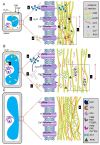The Role of Auxin in Cell Wall Expansion
- PMID: 29565829
- PMCID: PMC5979272
- DOI: 10.3390/ijms19040951
The Role of Auxin in Cell Wall Expansion
Abstract
Plant cells are surrounded by cell walls, which are dynamic structures displaying a strictly regulated balance between rigidity and flexibility. Walls are fairly rigid to provide support and protection, but also extensible, to allow cell growth, which is triggered by a high intracellular turgor pressure. Wall properties regulate the differential growth of the cell, resulting in a diversity of cell sizes and shapes. The plant hormone auxin is well known to stimulate cell elongation via increasing wall extensibility. Auxin participates in the regulation of cell wall properties by inducing wall loosening. Here, we review what is known on cell wall property regulation by auxin. We focus particularly on the auxin role during cell expansion linked directly to cell wall modifications. We also analyze downstream targets of transcriptional auxin signaling, which are related to the cell wall and could be linked to acid growth and the action of wall-loosening proteins. All together, this update elucidates the connection between hormonal signaling and cell wall synthesis and deposition.
Keywords: acid growth; auxin; cell expansion; cell wall.
Conflict of interest statement
The authors declare no conflict of interest.
Figures

Similar articles
-
Auxin, microtubules, and vesicle trafficking: conspirators behind the cell wall.J Exp Bot. 2017 Jun 15;68(13):3321-3329. doi: 10.1093/jxb/erx205. J Exp Bot. 2017. PMID: 28666373 Review.
-
BIIDXI, a DUF642 cell wall protein, is involved in hypocotyl growth via auxin efflux.J Plant Physiol. 2018 Dec;231:105-109. doi: 10.1016/j.jplph.2018.09.006. Epub 2018 Sep 17. J Plant Physiol. 2018. PMID: 30253266
-
"Shape of Cell"-An Auxin and Cell Wall Duet.Physiol Plant. 2025 May-Jun;177(3):e70294. doi: 10.1111/ppl.70294. Physiol Plant. 2025. PMID: 40442876 Free PMC article. Review.
-
Auxin protects Arabidopsis thaliana cell suspension cultures from programmed cell death induced by the cellulose biosynthesis inhibitors thaxtomin A and isoxaben.BMC Plant Biol. 2019 Nov 21;19(1):512. doi: 10.1186/s12870-019-2130-2. BMC Plant Biol. 2019. PMID: 31752698 Free PMC article.
-
Rhizobacterial volatile emissions regulate auxin homeostasis and cell expansion in Arabidopsis.Planta. 2007 Sep;226(4):839-51. doi: 10.1007/s00425-007-0530-2. Epub 2007 May 12. Planta. 2007. PMID: 17497164
Cited by
-
Division site determination during asymmetric cell division in plants.Plant Cell. 2022 May 24;34(6):2120-2139. doi: 10.1093/plcell/koac069. Plant Cell. 2022. PMID: 35201345 Free PMC article. Review.
-
Pepper Fruit Elongation Is Controlled by Capsicum annuum Ovate Family Protein 20.Front Plant Sci. 2022 Jan 4;12:815589. doi: 10.3389/fpls.2021.815589. eCollection 2021. Front Plant Sci. 2022. PMID: 35058962 Free PMC article.
-
Building a Flower: The Influence of Cell Wall Composition on Flower Development and Reproduction.Genes (Basel). 2021 Jun 26;12(7):978. doi: 10.3390/genes12070978. Genes (Basel). 2021. PMID: 34206830 Free PMC article. Review.
-
Albedo- and Flavedo-Specific Transcriptome Profiling Related to Penicillium digitatum Infection in Citrus Fruit.Foods. 2021 Sep 16;10(9):2196. doi: 10.3390/foods10092196. Foods. 2021. PMID: 34574307 Free PMC article.
-
Highlighting reactive oxygen species as multitaskers in root development.iScience. 2020 Dec 29;24(1):101978. doi: 10.1016/j.isci.2020.101978. eCollection 2021 Jan 22. iScience. 2020. PMID: 33490891 Free PMC article. Review.
References
-
- Fry S.C., Love J., Bryant J.A. Biofuels and Bioenergy. John Wiley & Sons, Ltd.; Hoboken, NJ, USA: 2017. Plant Cell Wall Polymers; pp. 59–87.
Publication types
MeSH terms
Substances
LinkOut - more resources
Full Text Sources
Other Literature Sources

